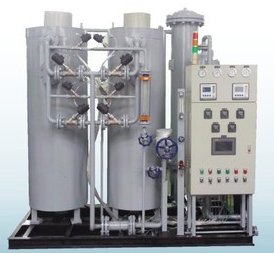Are you interested in understanding the preparation method of sulfur hexafluoride gas
Published on:2018-11-13 Click:487
Do you often hear about sulfur hexafluoride, but how much do you really know? How to make gas? What is the preparation method? I would like to share with you today the preparation process of sulfur hexafluoride. I hope it can help you!
Let's take a look at the history of sulfur hexafluoride. In 1900, Moissan and Lebeau obtained sulfur hexafluoride by burning sulfur in fluorine gas. In 1930, Schumb and Gamble also proposed the manufacturing method of sulfur hexafluoride. In 1941, the United Kingdom proposed the use of sulfur hexafluoride on transformers. In 1942, the Soviet Union also used sulfur hexafluoride on cables and accumulators. In 1948, the United States began the industrial production of sulfur hexafluoride. Now, the United States, Britain, France, Germany, Italy, Russia, Japan and other countries can produce sulfur hexafluoride, In particular, the Japanese Kanto Electrochemical Company and Asahi Subsidiary had a production capacity of 1000 t/a sulfur hexafluoride in the 1970s.
In industry, sulfur hexafluoride gas is usually prepared by reacting the fluoride generated by electrolysis with sulfur at medium and high temperatures. In addition to sulfur hexafluoride, it also generates a small amount of by-products such as sulfur tetrafluoride (SF4). The direct synthesis of sulfur hexafluoride from fluorine and sulfur can be divided into three ways: fluorine gas and solid sulfur, molten sulfur, and sulfur vapor: fluorine gas reacts with solid sulfur. Because the fluorine sulfur reaction is a very intense exothermic reaction, its reaction temperature is not easy to control, resulting in an increase in by-products and an increase in the burden of post-treatment. In addition, it is difficult to continuously add solid sulfur to the sealed reactor, so this method is not suitable for industrial production. The reaction between fluorine gas and sulfur vapor is to heat sulfur to above 445 ℃ (boiling point), so that sulfur can be converted into steam and sent to the reactor for reaction with fluorine. There is also a defect that the reaction temperature is difficult to control. The reaction temperature can reach above 600 ℃, so special reactor materials must be used. This method is not applicable to industrial production. The reaction of fluorine with molten sulfur is to keep the sulfur in the reactor in a molten state of 85~105 ℃ and react with the introduced fluorine. The reaction temperature is easy to control.
Sulfur hexafluoride gas is a colorless, odorless, non-toxic, incombustible and non corrosive gas at normal temperature and pressure. Its gas density is 61139 g/L, and its chemical stability is strong. It does not decompose at 500~600 ℃, and does not react with acids, alkalis, salts, ammonia and water. Under the action of electric arc (several thousand degrees), it decomposes into atomic gases of S and F, but once the electric arc is removed, it will be compounded into SF6 within 0~5~10~6 seconds. Sulfur hexafluoride has good electrical insulation performance and excellent arc extinguishing performance. Its electrical strength is 215 times that of nitrogen under the same pressure, the breakdown voltage is 215 times that of air, and the arc extinguishing capacity is 100 times that of air. It is a new generation of ultra-high insulation dielectric material superior to air and oil.
High purity sulfur hexafluoride has stable chemical properties. Slightly soluble in water, alcohol and ether, soluble in potassium hydroxide. It does not react chemically with sodium hydroxide, liquid ammonia, hydrochloric acid and water. It does not react with copper, silver, iron and aluminum in a dry environment below 300 ℃. It has no effect on quartz below 500 ℃. It reacts with metal sodium at 250 ℃ and in liquid ammonia at - 64 ℃. It decomposes when mixed with hydrogen sulfide. At 200 ℃, in the presence of specific metals such as steel and silicon steel, it can promote their slow decomposition.





